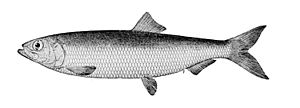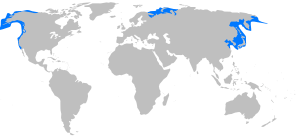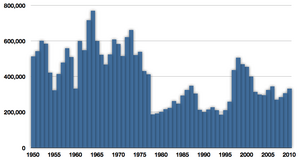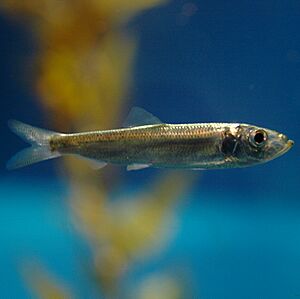Pacific herring facts for kids
Quick facts for kids Pacific herring |
|
|---|---|
 |
|
| Conservation status | |
| Scientific classification | |
 |
The Pacific herring, Clupea pallasii, is a type of herring fish. It lives in the Pacific Ocean near North America and northeast Asia. This fish has a shiny, silver body with fins that don't have spines. Its tail fin is deeply forked, like a "V".
You can find Pacific herring along the coast of California, all the way north to Alaska and the Bering Sea. In Asia, they live south to Japan. This fish is very important because it's a keystone species. This means it plays a big role in its ecosystem. Many other animals eat herring, and herring eat many small creatures.
Pacific herring lay their eggs at different times of the year. Often, they spawn in early spring. They lay eggs in shallow areas near the shore, or in slightly deeper waters. They usually lay eggs on eelgrass, seaweed, or other plants underwater. Unlike some fish, Pacific herring do not die after spawning. They can breed again in future years.
Sadly, the Pacific herring fishery (where people catch them) had problems in 1993. It is now slowly getting better in some areas of North America. The fish is named after Peter Simon Pallas, a famous German naturalist and explorer.
There are also some groups of Clupea pallasii in North-East Europe. These are often seen as different types, like the White Sea herring and the Chosha herring.
Contents
What Pacific Herring Look Like
Pacific herring have a bluish-green back and shiny silver-white sides and bellies. They don't have any other markings. Their silver color comes from tiny crystals in their skin. This helps them blend in with the water, which is a type of camouflage.
They have one fin on their back, right in the middle of their body. Their tail fin is deeply forked. Their bodies are flat from side to side. The scales on their belly stick out a bit, making them feel slightly rough. Unlike other fish in their family, they don't have scales on their heads or gills. Their scales are also large and easy to remove.
Most adult Pacific herring are about 33 centimeters (13 inches) long. Some can grow up to 45 centimeters (18 inches) and weigh up to 550 grams (about 1.2 pounds). Inside, the fish has many small bones and oily meat.
This fish does not have teeth on its main jaws. However, it does have some teeth on a bone called the vomer. Pacific herring have special eyes that help them find food in very dim light. They can also move up and down in the water very quickly. This is because they have a special nerve system connected to their gas bladder.
Pacific Herring Life Cycle
Pacific herring like to lay their eggs in calm bays and estuaries. Along the Pacific Coast of America, some important places are San Francisco Bay and Tomales Bay. Adult male and female herring swim from the open ocean into these bays around November or December. In colder northern areas, they might arrive a bit later.
Scientists are not fully sure what makes them start laying eggs. But after gathering in deeper water for weeks, both males and females move into shallower areas. They prefer to lay their eggs on underwater plants, especially eelgrass. A single female can lay as many as 20,000 eggs at one time. She does this by touching her belly to the plants underwater.
However, very few young herring survive to become adults. Only about one adult fish comes from every ten thousand eggs. This is because many other animals eat the eggs and young fish.
It seems that the males might start the spawning process. They release a substance called milt, which has a special smell (a pheromone). This smell might tell the females to start laying their eggs. The whole group of fish seems to spawn together. An entire school can lay eggs in just a few hours. This can create a very high density of eggs, sometimes up to 6 million eggs in one square meter.
The fertilized eggs are round and tiny, about 1.2 to 1.5 millimeters wide. They hatch in about ten days in water that is around 10 degrees Celsius (50 degrees Fahrenheit). Both the eggs and the young herring are eaten by many different predators.
Herring Fisheries

For a long time, Pacific herring have been an important fish. This is because they can produce a lot of fish biomass. Since 1975, divers from the Alaska Department of Fish and Game have tried to count the number of herring. However, these counts can change a lot.
First Nations people in British Columbia and other areas have fished for herring for a very long time. In 1997, a court decision recognized that the Heiltsuk Nation had a right to fish for herring, including for selling them.
Sadly, too many Pacific herring were caught. Because of this overfishing, the total North American Pacific herring fishery collapsed in 1993. It is now slowly getting better. Resource managers in North America are actively working to help the fish recover.
In some areas, the herring fishery collapsed at different times. For example, the fishery in Richardson Bay collapsed in 1983. Now, Pacific herring are starting to appear in good numbers again in several fishing areas. These include San Francisco Bay, Tomales Bay, and Sitka Sound. However, in other places, like Auke Bay in Alaska, the number of herring is still very low.
Today, Pacific herring are caught for bait (to catch other fish) and for their roe (eggs). In the past, they were also used to make fish oil and fish meal.
Conservation Efforts
On April 2, 2007, a group called the Sierra Club asked the U.S. government to protect Pacific herring in the Lynn Canal, Alaska. They wanted the herring to be listed as threatened or endangered. This would be under the U.S. Endangered Species Act (ESA).
On April 11, 2008, this request was turned down. The Lynn Canal herring population was not considered a separate group that needed protection. However, the National Marine Fisheries Service did decide to look into the status of a larger group of Pacific herring in Southeast Alaska. This wider group includes the Lynn Canal population. It stretches from Dixon Entrance north to Cape Fairweather and Icy Point.
On February 5, 2018, researchers at Western Washington University began studying why Pacific herring numbers are going down in Puget Sound. A main idea is that the loss of eelgrass is a big problem. Eelgrass is a very important place for herring to lay their eggs.
See also
 In Spanish: Arenque del Pacífico para niños
In Spanish: Arenque del Pacífico para niños



